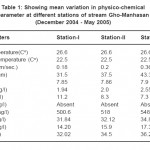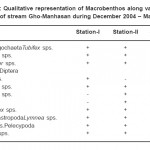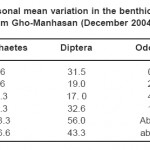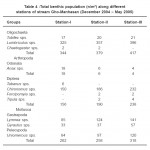Macrobenthic Fauna of a Local Stream, Ghomanhasan (Jammu)
Seema Langer1 * , A. Sharma1 and S. Parvez1
DOI: http://dx.doi.org/10.12944/CWE.6.1.23
Stream Gho-Manhasan is analysed for physical, chemical and biological status of its water. Variations both in water and benthic life inhabiting the stream were noted down.
Copy the following to cite this article:
Langer S, Sharma A, Parvez S. Macrobenthic Fauna of a Local Stream, Ghomanhasan (Jammu). Curr World Environ 2011:6(1);159-163 DOI:http://dx.doi.org/10.12944/CWE.6.1.23
Copy the following to cite this URL:
Langer S, Sharma A, Parvez S. Macrobenthic Fauna of a Local Stream, Ghomanhasan (Jammu). Curr World Environ 2011:6(1);151-157. Available from: http://www.cwejournal.org/?p=1309
Download article (pdf)
Citation Manager
Publish History
Select type of program for download
| Endnote EndNote format (Mac & Win) | |
| Reference Manager Ris format (Win only) | |
| Procite Ris format (Win only) | |
| Medlars Format | |
| RefWorks Format RefWorks format (Mac & Win) | |
| BibTex Format BibTex format (Mac & Win) |
Article Publishing History
| Received: | 2011-03-19 |
|---|---|
| Accepted: | 2011-04-20 |
Introduction
The nature of flora and fauna in any water body is mainly controlled by the fluctuations in the physical and chemical characteristics of its water. Moreover physico-chemical aspects are pre-requistic for the assessment of potentialities and to understand the realities between trophic level food webs.
Gho-Manhasan, one of the tributaries of Chenab drainage system before its entry into Pakistan passes through the North of Jammu province. This stream acts as a recipient of various effluent from villages located on its sides. Besides this, stream water is also used for washing of clothes by local inhabitants. A large number of cattle also visit for drinking or bathing purposes. All the effluents entering the stream are liable to deteriorate its water quality thereby making it unfit for drinking and other purposes.
Keeping in view the above factors, a maiden attempt has been made to study its status thereby determining the impact of anthropogenic influence on the biotic life inhabiting this water body.
Study Area and Material and Methods
The stream has been divided into three stations along the longitudinal profile. Station I & II are slightly polluted while station III is heavily polluted and receives effluent from the village Gho Manhasan. Monthly samples were collected. The study period comprised of 6 months from December 2004 – May 2005 thereby constituting winter/ summer/spring seasons. Water samples were analysed following APHA (1985).
Soil samples were taken from 3 different stations with a sieve of known mesh size and brought to laboratory. Samples were washed and macrobenthos were taken out with the help of brush and preserved in 5% formalin. These organisms were then identified following Ward and Whipple (1959), Needham and Needham (1962), Adoni (1985) and Pennak (1989).
Results and Discussion
Water Quality
Water sample has been analysed for temperature, speed, depth, Dissolved Oxygen, Free Carbondioxide, Calcium, Magnesium, Bicarbondate, Carbonate and Chloride. The results as presented in Table I show minor variations in their mean value at different stations. Station I experiences highest speed and lowest depth while its speed goes on declining with an increase in depth downstream. pH does not show much fluctuation, CO32- remains absent throughout study period. Other parameters like HCO3-, Mg++, Ca++ and Cl- experience slightly increased values downstream and their highest concentration is recorded at station III.
 |
Table 1: Showing mean variation in physico-chemical parameter at different stations of stream Gho-Manhasan (December 2004 - May 2005) Click here to View table |
 |
Table 2: Qualitative representation of Macrobenthos along various stations of stream Gho-Manhasan during December 2004 – May 2005 Click here to View table |
 |
Table 3: Seasonal mean variation in the benthic population (n/m2) of stream Gho-Manhasan (December 2004 – May 2005) Click here to View table |
Macrobenthic Community
The stream is populated mainly by Annelida, Arthropoda & Mollusca. Among the three groups, Arthropods dominated qualitatively and Annelids quantitatively. Different stations of the stream exhibit varied diversity at the sps. level (Table 2).
The seasonal variation in macrobenthic community along with maxima & minima has been depicted in the Table 3.
Oligochaetes
Highest number of oligochaetes (Table 3) in summer months may be associated with organically rich bottom and increased temperature which enhances organic production. Sunder and Subla (1986) also linked their abundance with rising temperature. Its decline in winter months may be attributed to the low temperature (Pennak, 1989).
In stream Gho-Manhasan, three sps. of oligochaetes have been reported viz, Tubifex, Lumbriculus and Chaetogaster. Tubifex and Lumbriculus are found abundantly at station III (Table 4) through out the study period that may be attributed to the organically rich bottom. Moreover this station is also under the influence of anthropogenic factors which lead to the increase in the apparent pollution level. These observation are also supported by Gopal and Sah (1993) and Sharma (1999) who also reported their abundance in polluted zone.
Diptera
The summer peak of dipterans (Table 3) can be attributed to the reduced flow and high water temperature. Present findings are supported by Stehr and Branson (1938) and Gopal and Sah (1993). The winter rains during February are found responsible for their less number as they wash away the substratum along with the benthic fauna {Pennak and Gerpan, (1947), Nelofar (2003) and Sawhney (2004)}.
 |
Table 4: Total benthic population (n/m2) along different stations of stream Gho-Manhasan (December 2004 – May 2005) Click here to View table |
Dipteran are represented by four species viz. Tabanus sps, Chironomus sps, Forcipomyia and Tipula. Station III recorded the highest number of Chironomus (Table 4). The water quality of the station favour their abundance as the water receives effluents from various sources and pollutants get stranded on its bank thereby making it rich in organic matter and Carbondioxide and poor in Oxygen. A decline in DO level also favours the healthy growth of Chironomus sps (Sharma 1999 and Sawhney 2004).
Odonata
The maximum production of odonates during winter months (Table 3) can be attributed to low temperature as it favours the abundance of their larvae by inhibiting metamorphosis. Such finding are in concordance with Anwar and Siddiqui (1988) and Chopra et al. (1993).
Molluscs
Summer peak of molluscs show direct relationship with high concentration of bicarbonate and calcium (Table 1). Increasing water temperature during summers is also advantageous to the rich population of molluscs. Present findings also get support from the observation already recorded by Stout and Vandermeer (1978), King (1983) and Rosillion (1985).
Their minimum density can be attributed to low temperature as has already been discussed by Dutta and Malhotra (1986) and Thakial (1997).
Molluscs are represented by three species with their maximum abundance at station III, their increase in number can be related to increasing concentration of bicarbonate, calcium and chloride which favour high population of Molluscs. Present findings are also in concordance with the findings made by David and Ray (1968) and Sunder and Subla (1986). In addition to these factors low speed and high depth at Station III also lead toward its pooled nature and there by supporting the rich population of molluscs.
On the basis of the above discussion it can be concluded that pollution has direct effects on physico-chemical quality of water which ultimately affect the benthic life thereby causing their population to appear or disappear from a water body.
References
- A.P.H.A., Standard methods of the examination of waste and waste water. 16th edn. American Public Health Association, Washington D.C (1985).
- Adoni, A.D., Workbook on limnology Pratibha Publishers, C-10 Gour Nagar Sagar. 470003, India: 216 (1985).
- Anwar, S. and M.S. Siddiqui, On the distribution and dynamics of macro-invertebrates fauna of the river Kali in Northern India J. Environ. Biol 9(3): 333-341 (1988).
- Chopra, A.K., B.P. Madhwal and H.R. Singh, Relationship between abiotic variables and benthic fauna of river Yamuna in Garhwal Himalaya Indian. J. Ecol. 20(I): 53-58 (1993).
- David, A. and P. Ray, Studies on the pollution of river Daha (N. Bihar) by sugar and distillery waters. Environ. Health 7: 6-35 (1968).
- Dutta, S.P.S. and Malhotra, Y.R., Seasonal variation in the macrobenthic fauna of Gadigarh stream (Miran Sahib), Jammu. Indian J. Ecol. 131: 138-145 (1986).
- Gopal, Brij and Malavika Sah., Conservation and management of river in India: Case study of river Yamuna. Environmental conservation.20(2): 243-253 (1993).
- King, J.M., Abundance, Biomass and diversity of benthic macroinvertebrates in a western cape river south Africa. Trans. Rov. Soc. S. Afr. 45(1) (1983).
- Needham, J.G. and P.R. Needham, Fresh water biology. Holden Day Inc. San. Francisco (1962).
- Nelofer, N., Limnology of a high altitude Sarkoot pond (Kishtwar). M. phil dissertation submitted to University of Jammu, Jammu (2003).
- Pennak, P.W. and Ernest, D. Van. Gerpen, Bottom fauna production and the physical nature of the substrate in a Northern Colorado Trent stream. Ecology, 28(1): 42-48 (1947).
- Pennak. R.W., Freshwater invertebrate of the United States (protozoa-molluscs) 3rd Edition. A Wiley inter science Publication John Wiley and Sons. Inc. 628 (1989).
- Rosillon, D., Seasonal variation in the benthos of a chalk trout stream, the river Samson, Belgium Hydrobiologia, 126: 253-262 (1985).
- Sawhney, N., Limnology of Ban Ganga with special reference to some consumers inhabiting the stream. M. Phil: Dissertation submitted to University of Jammu, Jammu (2004).
- Sharma, A., Limnolgical studies of Ban-Ganga and distributional pattern of stream fauna. Ph. D. thesis submitted to University of Jammu, Jammu (1999).
- Stehr, WML and J. Wondell Branson, An ecological study of an intermittent stream. Ecology 19(2): 294-311 (1938).
- Stout Jean and Vandermeer, Composition of sps. richness for stream inhabiting insects in tropical and mid-altitude streams. Amer Natur. 109: 263-280 (1978).
- Sunder, S. and Subla, B.A., Macrobenthic fauna of a Himalayan river. Indian J. Ecol. 13(1): 127-132 (1986).
- Thakial, M.R., Studies on benthos in some habitats of Jammu Ph. D. thesis submitted to the University of Jammu, Jammu (1997).
- Ward, H. B. and G.C. Whipple, Fresh water biology II. John Wiley and sons, Inc., New York, London, Sydney: 1243 (1959).






